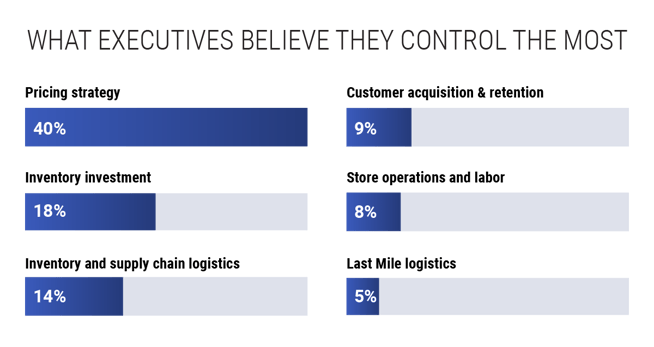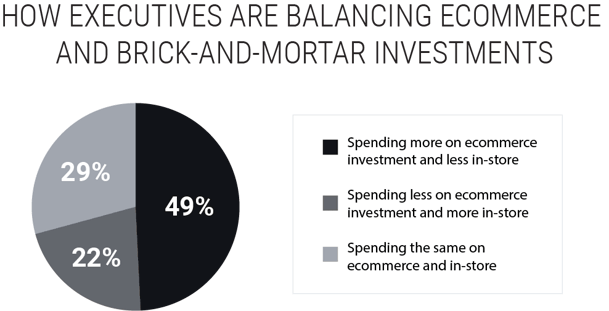Even the most successful retailers need to look under the microscope across key areas to stay ahead. As consumers continue to shop more fluidly between e-commerce and physical stores, winning brands maximize both channels to provide a highly engaging experience with a profitable return on investment.
You're finally wrapping up another quarter, putting the finishing touches on your sales reports, and getting back to the 'normal' swing of things...when you're boss or a member of your team asks: "What ideas do you have for us to grow this year?" Before you slam your head on the desk or send that snarky email, take a look at these six strategies for retail growth.
Top Growth Strategies for Retailers
We surveyed retail executives in our report, The Inflation Disconnect Between Retail Executives and Consumers uncovered what's keeping leaders up at night. They noted their top priorities as 1. Growth strategies, 2. Customer acquisition and retention, 3. Store operations, 4. Supply chain capabilities, 5. Machine learning and AI, and 6. Metaverse. With growth being top-of-mind, here are practical retail growth strategies for coming out on top during changing trends and what's next in the industry.
- Customer Acquisition and Retention
- Pricing Strategies
- Online vs In-Store Investment
- Ecommerce Services
- Making the Right Investments
- Balancing Growth
Customer Acquisition and Retention
A top way to grow revenue in difficult economic times is by increasing market share. However, a customer acquisition strategy is useless without a customer retention strategy. Targeting competitors’ customers with sharper pricing, better service, or more personalized experiences always pay off.
Data acquired directly from consumers, through apps, loyalty programs, and other strategies guarantees a more engaging relationship across the board.
Retailers and brands with physical stores know that in-person is their best opportunity to make an impression that lasts. A few ways to build loyalty are to ensure a superlative in-store experience through store design, customer service, technology, and even seamless transitions between online and offline services (click and collect, curbside pickup, returns, etc.).
Another way to keep customers happy is to give them the desired products. Optimizing assortments with First Insight’s powerful suite of predictive tools ensures that profits are maximized, and low-value products eliminated even before going into production. InsightSuite helps create profitable assortments and delivers accurate predictions for product selection and SKU rationalization while also identifying high-value or even complimentary products.
Pricing Strategies
Data-driven pricing is critical to any growth strategy, allowing retailers to increase margins at every point in the product lifecycle.
Have you ever made a purchase and expected to pay a lot more than what it was priced at? That's how money is left on the table. Pricing strategy is important to retail growth because it can have a significant impact on demand for a product or service. Prices that are too high may discourage potential customers from making a purchase, while prices that are too low may not generate enough revenue to hit product performance goals. Both impact your bottom line.

An effective pricing strategy considers the cost of producing and distributing a product or service, as well as the value that it offers to customers. It also factors in the competitive landscape and market demand, as well as the retailer’s overall business goals.
By carefully considering these factors, retailers can set prices that are competitive and sustainable, while maximizing their revenue and profitability. This can help drive growth and support the long-term success of the business.
We have found that in difficult economic times, 40% of retail executives believe that pricing is the part of their business that they control the most. InsightPricing gives businesses control of their pricing strategy by helping them set an optimal initial price right from the start. Make better data-driven decisions with price optimization tools. Even new-to-market products, traditionally the hardest to price due to the absence of historical data, can be more effectively priced with First Insight’s software.
Understanding the price elasticity curve aids in forecasting an average selling price, even before the product is launched. InsightPricing identifies margin movers, those products which can support an opening price point higher than originally planned, maximizing gross margin revenue.
Online vs Physical Retail Investment
A sound growth strategy balances investment in both physical retail and digital, but this isn’t a strategy many retail executives are employing. Our report illustrating the disconnect between retail executives and consumers asked retailers how they are balancing investments in online and physical retail. The e-commerce boom created by the pandemic has eased somewhat as more and more consumers regained the confidence to return to stores. However, just about half of the retail executives we queried said that they would be investing more in e-commerce channels than in physical retail locations. Twenty-nine percent will spend the same on both, and 22% will spend more on physical retail.

Most retailers should be doing more to leverage each asset off the other. Technology, such as First Insight’s Customer Experience Management solution, provides retailers with deep insights to help them anticipate customers’ needs.
- Test before you invest. Drive the most revenue from each aspect of a physical retail location with store layout testing before undertaking labor-intensive resetting or redesigning.
- How can in-store technology be leveraged to better serve both the shopper and the store associates? Tech for tech’s sake is a waste of money, but solutions that make it easier for consumers to find what they are looking for in-store or help sales associates save time by supporting them with returns is always worth the investment.
- Should retailers charge for returns? The short answer is no according to our consumer report on returns. A majority will not shop at a retailer that charges for returns. Are there ways, though, that shoppers will compromise? Perhaps there are alternatives such as if a shopper is a member of the store’s loyalty program or accepting a shorter returns window for expedited shipping.
E-commerce Services
E-commerce services allow retailers to reach a wider customer base, both domestically and internationally. With an online presence, retailers can reach consumers with a click of a button and at all hours of the day.
E-commerce also provides several other benefits to retailers including:
- Increased convenience for customers: Customers can shop online at any time, from any location, without the need to visit a store.
- Lower overhead costs: E-commerce businesses typically have lower overhead costs compared to brick-and-mortar stores, as they don’t have a physical storefront and can often operate with a smaller team.
- Greater opportunities for personalization: Using data from online interactions to personalize the shopping experience for each customer can lead to greater customer loyalty and sales.
- More opportunities for expansion: With an e-commerce presence, retailers can easily expand into new markets and geographies, helping to drive growth.
Growth strategy considerations for e-commerce that go beyond SEO optimization and Google AdWords include:
- Try before buying
- Subscriptions
- Metaverse product testing
- One-click checkout
- Optimizing the post-checkout experience
- Bolster personalization with AI
- Wardrobe or product bundling
Overall, e-commerce services can help retailers reach a larger and more diverse customer base, while also providing a range of operational and strategic benefits that can support the growth and success of a business.
Making the Right Investment
Developing the right growth strategies can be hard. The most important decision any retail leader can make is where, when, and how to deploy assets across store design, website upgrades, human resources, marketing, logistics, and product development. First Insight supports executives with actionable data utilizing artificial intelligence, machine learning, and predictive analytics.
First Insight found that 51% of retailers plan to invest more in voice of the customer and assortment/pricing predictive analytics technology to help them understand how to improve their decision-making. Furthermore, 60% of retail executives believe that these tools are important to their businesses. Knowing, not guessing, which growth strategies to employ is the best way forward to drive the highest return on investment.
Balance Growth by Adopting Customer-Centric Technology
Balancing growth can be challenging, as retailers must find a way to grow their business while also maintaining profitability. It’s important to invest in growth strategies though as they are essential for driving the success and long-term sustainability of the company. Without a focus on growth, a retailer may struggle to keep up with changing market conditions and customer demands, and may eventually be outpaced by competitors.
There’s no effective growth strategy that does not partner with retailers’ most important constituency—the customer. Knowing how they will respond can be managed efficiently with a combination of voice of the customer data and predictive analytics. First Insight’s Retail Decision Platform takes the guesswork out of decision-making by letting retailers know what their customers are thinking:
- Test marketing messaging before going public to make sure it resonates with its intended audience.
- Avoid public relations disasters. Catch offensive products or messaging before it’s too late.
- Know what customers expect for their loyalty—whether that’s free shipping, free returns, extra discounts, or something completely unexpected.
- Launch new products, pricing strategies, and store design with confidence.

















